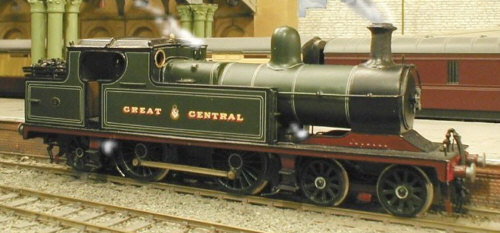The Robinson C13 (GCR Class 9K) Atlantic Tank Engines

Introduced in 1903, the C13 (GCR Class 9K) was Robinson's first suburban tank design; and is usually considered to be one of his most successful designs. The C13 was based on Pollitt's F2 2-4-2T design, but with a longer firebox and a longer smokebox. The firebox was also deeper, and the boiler lengthened slightly. Interestingly, the saturated C13s closely resembled the smaller 4-4-2Ts which Robinson had previously built for the Waterford Limerick & Western Railway in Ireland.
A total of forty locomotives were built in four batches between 1903 and 1905. A further twelve locomotives were built in 1907 but with increased coal and water capacities. These were given the classification of C14 by the LNER.
In 1915, No. 18 was fitted with a superheater, and would remain the only superheated C13 until after Grouping in 1923. The LNER fitted superheaters to the remaining C13s between 1926 and 1935. In order to increase route availability, shorter chimneys and domes were usually fitted at the same time as the superheaters were fitted, although there were exceptions. Saturated C13s were classified C13/1, whilst the superheated C13s with shorter chimneys and domes were classified C13/3. Superheated C13s which retained either the tall chimney and/or tall dome were classified C13/2. The part classification was dropped at the end of 1938, after all of the C13s were superheated and converted to the LNER 13ft loading gauge.
The GCR installed water troughs in 1903, and water scoops were fitted to the C13s shortly afterwards. The scoops were rarely being used by 1932, and they were removed between 1932 and 1935.
In 1933, six C13s were fitted for operating push-pull auto trains with the GCR mechanical system. These were soon altered to the LNER's own vacuum system, and two further C13s were converted in 1941.
Constructed for both suburban and branchline passenger work, the C13s started their careers in the London area before being displaced by the A5 4-6-2Ts. By 1922 they had moved north to Wrexham, Trafford Park, Sheffield, and Mexborough. Large numbers of C13s were based at Wrexham between 1905 and the mid-1950s, easily handling the steep Welsh lines in the area.
Transfers to Gorton started in 1935, replacing older F1 2-4-2T locomotives on suburban Manchester services. The C13s continued to perform excellent work on these services well into British Railways (BR) ownership, even out-performing modern LMS 2-6-4T types.
Withdrawals started in 1952, and were finished in 1960 with the withdrawal of No. 67417 from Gorton.
Technical Details
| Saturated | Superheated | ||
| Cylinders (x2): | (inside) | 18x26in. | 18x26in. |
| Motion: | Stephenson (slide valves) | Stephenson (slide valves) | |
| Boiler: | Max. Diameter: | 4ft 4in | 4ft 4in |
| Pressure: | 160psi | 160psi | |
| Diagram No.: | 22 | 22 | |
| Heating Surface: | Total: | 1101 sq.ft. | 1031 sq.ft. |
| Firebox: | 108 sq.ft. | 108 sq.ft. | |
| Tubes: | 993 sq.ft. (190x 1.75in) | 503 sq.ft. (90x 1.875in) | |
| Flues: | 282 sq.ft. (18x 5.25in) | ||
| Superheater: | 138 sq.ft. (18x 1.06in) | ||
| Grate Area: | 19.59 sq.ft. | 19.59 sq.ft. | |
| Wheels: | Leading: | 3ft 6in | 3ft 6in |
| Coupled: | 5ft 7in | 5ft 7in | |
| Trailing: | 3ft 9in | 3ft 9in | |
| Tractive Effort: | (@ 85%) | 17,100lb | 17,100lb |
| Total Wheelbase: | 29ft 10.5in | 29ft 10.5in | |
| Engine Weight: | (full) | 66 tons 13cwt | 66 tons 13cwt |
| Max. Axle Load: | 18 tons 10cwt | 18 tons 10cwt | |
| Coal Capacity: | 3 tons 13cwt | 3 tons 13cwt | |
| Water Capacity: | 1450 gallons | 1450 gallons |
Preservation
None of the C13 Atlantics survived into preservation.

Models
Nu-cast produce a whitemetal OO gauge (4mm scale) kit of the C13.
O gauge (7mm scale) kits are available from Gladiator and ACE Products.
Acknowledgements
Thank you to 'Colombo' (from the forums) for the photograph of Arnie Buxton's 4mm C13 model running on his York layout.
Thank you to Malcolm Peirson for the works photograph of No. 1129.